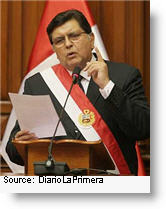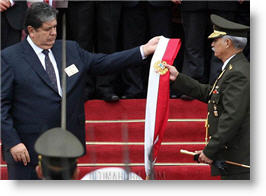 President Alan Garcia delivered his last message to the nation in Congress Wednesday, highlighting his government’s successes over the past five years and apologizing to those he may have offended.
President Alan Garcia delivered his last message to the nation in Congress Wednesday, highlighting his government’s successes over the past five years and apologizing to those he may have offended.
Garcia, 62, stepped down the following day,Thursday, succeeded by left-leaning former military officer Ollanta Humala. Accompanied by his cabinet members, he attended the Te Deum and mass in the cathedral, his last as President, but refused to attend the inauguration ceremony in Congress on the grounds that he had no intention of facing the booing and catcalls of his critics.
Breaking with protocol, he handed over the presidential sash to the head of the Military House at the Government Palace after the church service, to be delivered to Congress.
The tradition is that the outgoing President hands his presidential sash to the head of Congress, who in turn places it on the incoming head of state.
before new president of Congress, Daniel Abugattas, at the end of his Wednesday speech.
 During his televised speech, Garcia pointed to the decline in the poverty rate from 48% at the beginning of his administration in 2006 to approximately 30% today, on the back of Peru’s red hot economic growth.
During his televised speech, Garcia pointed to the decline in the poverty rate from 48% at the beginning of his administration in 2006 to approximately 30% today, on the back of Peru’s red hot economic growth.
Garcia said that more than 3.2 million people received electricity for the first time during his administration, while 10,500 kilometres of roads were paved. In addition, 840,000 property titles were awarded.
“What touches my soul the most is that almost 1.7 million Peruvians learned to read, making our country free of illiteracy,” Garcia said. His statistics are questioned by critics.
He went on to say that over the past five years Peru has seen 2.3 million new jobs and that the gap between the richest 20% of the population and poorest 20% has narrowed.
“What is important is that in this world of competition and information, Peru’s economic and social progress was much greater than all of the countries in Latin America,” Garcia said.
The President added: “I have always maintained… that the purpose of a good government is to provide bread with liberty and I can say now that we have consolidated political and social democracy in our country.”
Peru finds itself in a much better position at the end of Garcia’s second administration than his first (1985-1990), when the country was mired in hyperinflation and battling a bloody insurgency by the Shining Path.
Nevertheless, Garcia’s second term was not without controversy and critics say he has left time bombs in numerous areas for the incoming administration.
One of these areas is social conflicts, which have skyrocketed during Garcia’s administration as rural communities looked to block the development of major energy and mining projects, in protest against the government’s lack of prior consultation and concerns for environmental impact of the projects.
During Garcia’s first year in this second term, 2006, there were approximately 60 social conflicts filed at the Ombudsman’s office. He leaves with more than 220 social conflicts in process that, according to the Ombudsman’s office, could have been avoided if the government had negotiated and sought solutions much earlier in each case.
The conflicts have led to about 100 deaths as protesters clashed with police.
The most serious conflict came in June 2009 when indigenous protesters in the jungle province of Bagua clashed with soldiers and police on a remote highway.
The Bagua protesters were demanding, besides the right to prior consultation established by law, the repeal of several Executive decrees enacted in 2008 by Garcia to provide attractive investment conditions for the Free Trade Agreement signed with the United States. Twenty-four police officers and 10 civilians were killed in the protests.
“The social conflicts increased in number and intensity,” said Jose de Echave, an expert on the topic at NGO Cooperaccion. “It is mainly due to socio-environmental, mining and hydrocarbon policies.”
Meanwhile, analysts have pointed to Peru’s growing drug trade as another failure in Garcia’s administration and major challenge to Humala’s incoming government.
Peru has seen a steady rise in coca production during the last decade and is today the world’s top producer of the raw material used to make cocaine ahead of Colombia, the world’s other major producer along with Bolivia.
In 2010, Peru saw a 2 percent increase in the area under coca cultivation to 61,200 hectares, according to the UN World Drug Report. Production is focused in two regions, the Upper Huallaga Valley, located in Huanuco, and the Apurimac and Ene River Valley (VRAE).
Former foreign affairs minister and recent presidential candidate, Manuel Rodriguez, said the drug trade will be one of Humala’s “gravest challenges.”
The drug trade in Peru is complicated by the Shining Path remnant groups that periodically launch deadly attacks on state efforts to erradicate coca fields. The groups operate as hired guns in the VRAE and Upper Huallaga Valley.
Finally, critics of Garcia have also pointed to the numerous corruption cases that arose during the past five years, drawing comparisons back to his corruption-riddled first term as president.
The biggest corruption case came in 2008 with the broadcasting of an illegally recorded phone conversation by Sunday night investigative TV news program Cuarto Poder between ex-Perupetro vice-president Alberto Quimper and business negotiator Romulo Leon Alegria, a prominent member of Garcia’s Aprista party.
In the recordings, the men allegedly discussed under-the-table payments conditioned on Norwegian Discover Petroleum company obtaining oil exploration concessions.
A week after the first tapes were released to the press, new tapes surfaced in which Leon allegedly told a Discover representative that Garcia’s cabinet chief at the time, Jorge Del Castillo, could be counted on to provide influence to help clinch a winning bid in the oil block auction. The scandal forced a major cabinet shuffle. The Business Track trial, covering these tapes and other illegal tapping, is currently in process and includes the questioning of several high-ranking Apristas, including Del Castillo and possibly Alan Garcia himself.
Then-candidate Humala seized on the corruption allegations to call for the immediate ouster of the Garcia administration. During his presidential campaign, he also promised that tackling corruption would be a priority for his administration.





